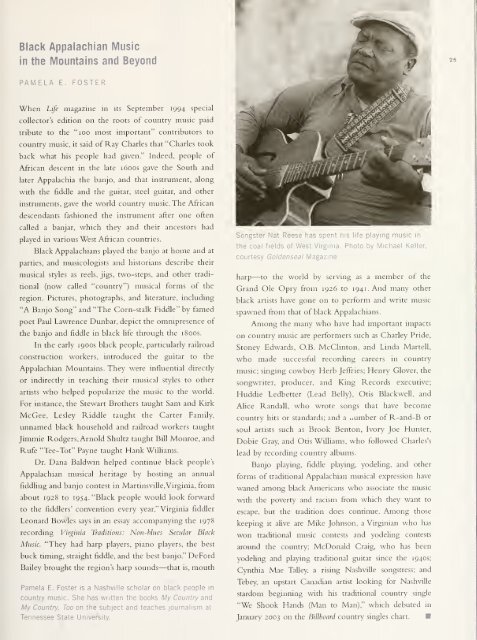SCOTLAND - Smithsonian Digital Repository - Smithsonian Institution
SCOTLAND - Smithsonian Digital Repository - Smithsonian Institution
SCOTLAND - Smithsonian Digital Repository - Smithsonian Institution
You also want an ePaper? Increase the reach of your titles
YUMPU automatically turns print PDFs into web optimized ePapers that Google loves.
Black Appalachian Music<br />
in the Mountains and Beyond<br />
25<br />
PAMELA E.<br />
FOSTER<br />
When Life magazine in its September 1994 special<br />
collector's edition on the roots of country music paid<br />
tribute to the "100 most important" contributors to<br />
country music, it said of Ray Charles that "Charles took<br />
back what his people had given." Indeed, people of<br />
African descent in the late 1600s gave the South and<br />
later Appalachia the banjo, and that instrument, along<br />
with the fiddle and the guitar, steel guitar, and other<br />
instruments, gave the world country music. The African<br />
descendants fashioned the instrument after one often<br />
called a banjar, which they and their ancestors had<br />
played in various West African countries.<br />
Black Appalachians played the banjo at home and at<br />
parties, and musicologists and historians describe their<br />
musical styles as reels, jigs, two-steps, and other traditional<br />
(now called "country") musical forms of the<br />
region. Pictures, photographs, and literature,<br />
including<br />
"A Banjo Song" and "The Corn-stalk Fiddle" by tamed<br />
poet Paul Lawrence Dunbar, depict the omnipresence of<br />
the banjo and fiddle in black life through the 1800s.<br />
In the early 1900s black people, particularly raOroad<br />
construction workers, introduced the guitar to the<br />
Appalachian Mountains. They were influential<br />
directly<br />
or indirectly in teaching their musical styles to other<br />
artists who helped popularize the music to the world.<br />
For instance, the Stewart Brothers taught Sam and Kirk<br />
McGee, Lesley Riddle taught the Carter Family,<br />
unnamed black household and railroad workers taught<br />
Jimmie Rodgers, Arnold Shultz taught Bill Monroe, and<br />
Rufe "Tee-Tot" Payne taught Hank Williams.<br />
Dr. Dana Baldwin helped continue black peoples<br />
Appalachian musical heritage by hosting an annual<br />
fiddling and banjo contest in Martinsville, Virginia, from<br />
about 1928 to<br />
1954. "Black people would look forward<br />
to the fiddlers' convention every year," Virginia fiddler<br />
Leonard Bowles says in an essay accompanying the 1978<br />
recording Virginia Traditions: Non-hlues Secular Black<br />
Music. "They had harp players, piano players, the best<br />
buck timing, straight fiddle, and the best banjo." DeFord<br />
Bailey brought the region's harp sounds—that is, mouth<br />
Pamela E.<br />
Foster is a Nashville scholar on black people in<br />
country music. She has written the books My Country and<br />
My Country, Too on the subject and teaches journalism at<br />
Tennessee State University.<br />
Songster Nat Reese has spent his life<br />
the coal fields of West Virginia.<br />
courtesy Goldenseal Magazine<br />
playing music in<br />
Photo by Michael Keller,<br />
harp—to the world by serving as a member of the<br />
Grand Ole Opry from 1926 to i94i.And many other<br />
black artists<br />
have gone on to perform and write music<br />
spawned from that of black Appalachians.<br />
Among the many who have had important impacts<br />
on country music are performers such as Charley Pride,<br />
Stoney Edwards, O.B. McClinton, and Linda MarteU,<br />
who made successful recording careers in country<br />
music; singing cowboy Herb Jeffries; Henry Glover, the<br />
songwriter, producer, and King Records executive;<br />
Huddie Ledbetter (Lead Belly), Otis Blackwell, and<br />
AUce Randall, who wrote songs that have become<br />
country hits or standards; and a number of R-and-B or<br />
soul artists such as Brook Benton, Ivory Joe Hunter,<br />
Dobie Gray, and Otis Williams, who followed Charles's<br />
lead by recording country albums.<br />
Banjo playing, fiddle playing, yodeUng, and other<br />
forms of traditional Appalachian musical expression have<br />
waned among black Americans who associate<br />
with the<br />
the music<br />
poverty and racism from which they want to<br />
escape, but the tradition does continue. Among those<br />
keeping it alive are Mike Johnson, a Virginian who has<br />
won traditional music contests and yodeling contests<br />
around the country; McDonald Craig, who has been<br />
yodehng and playing traditional guitar since the 1940s;<br />
Cynthia Mae TaUey, a rising Nashville songstress; and<br />
Tebey, an upstart Canadian artist looking for Nashville<br />
stardom beginning with his traditional country single<br />
"We Shook Hands (Man to<br />
Man)," which debuted in<br />
January 2003 on the Billboard country singles chart.
















